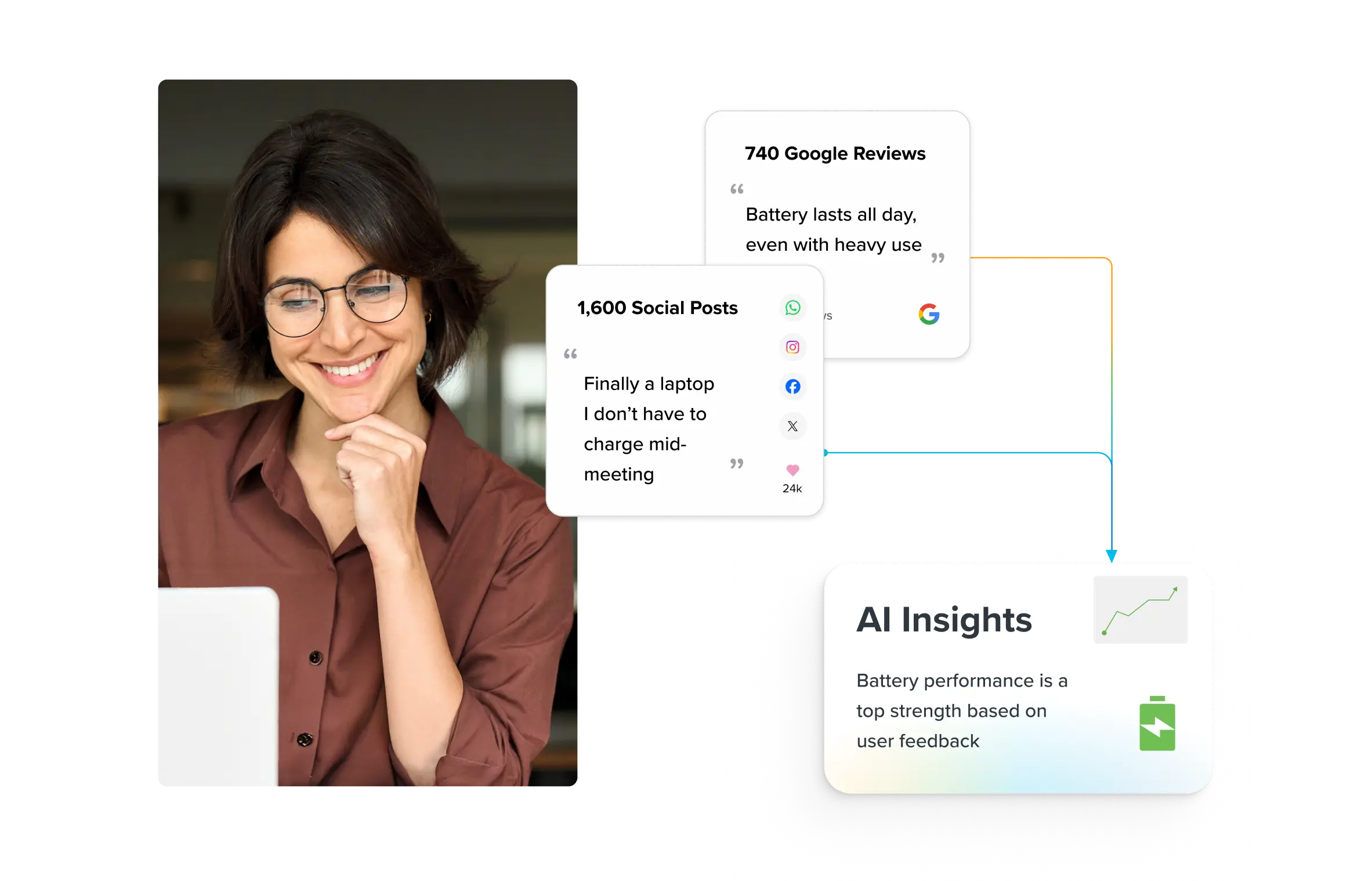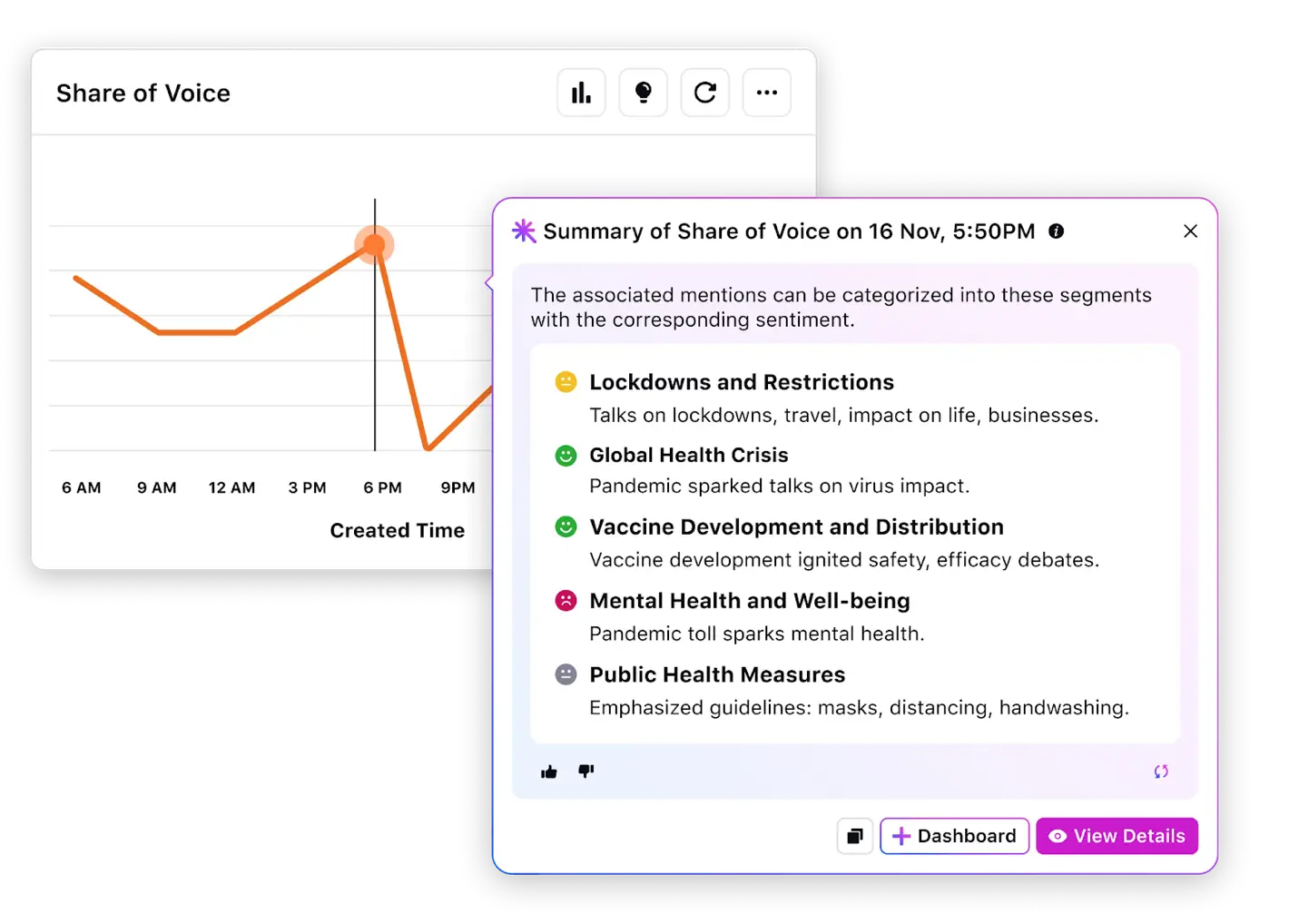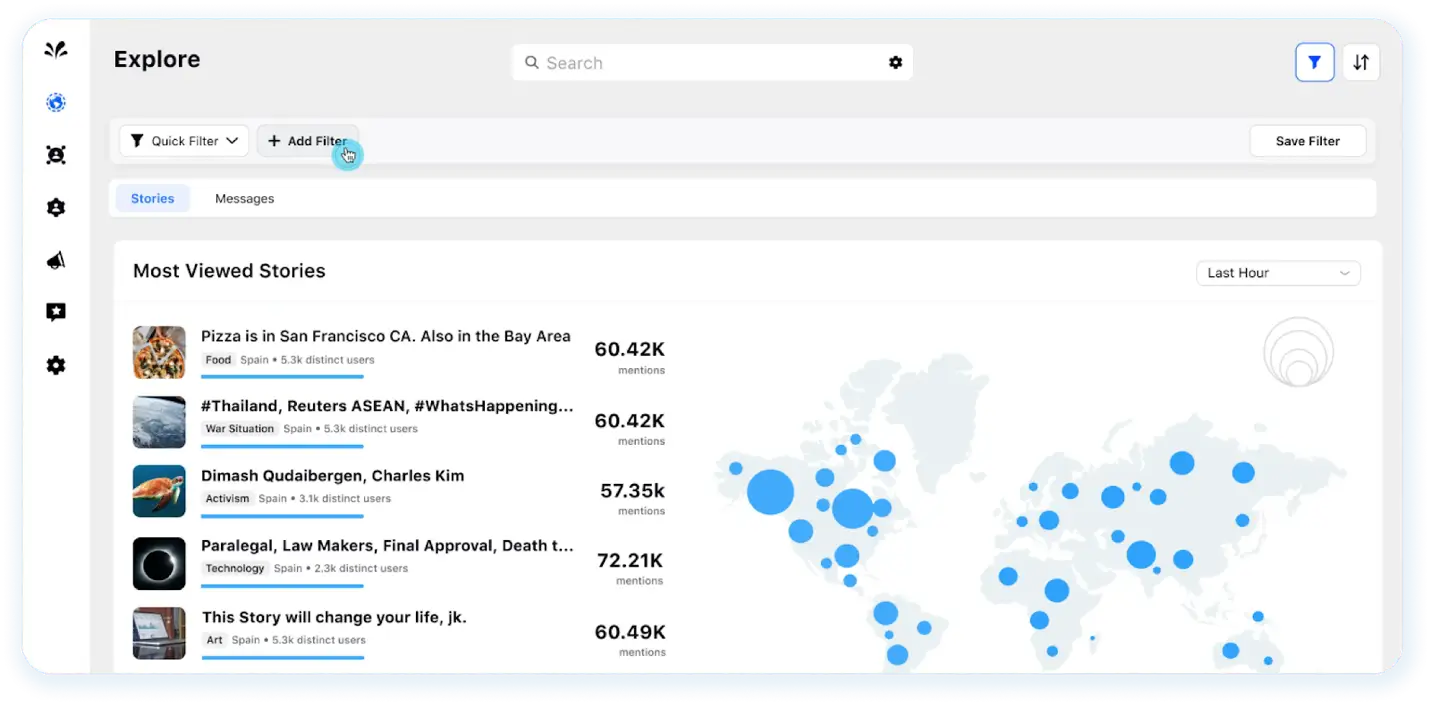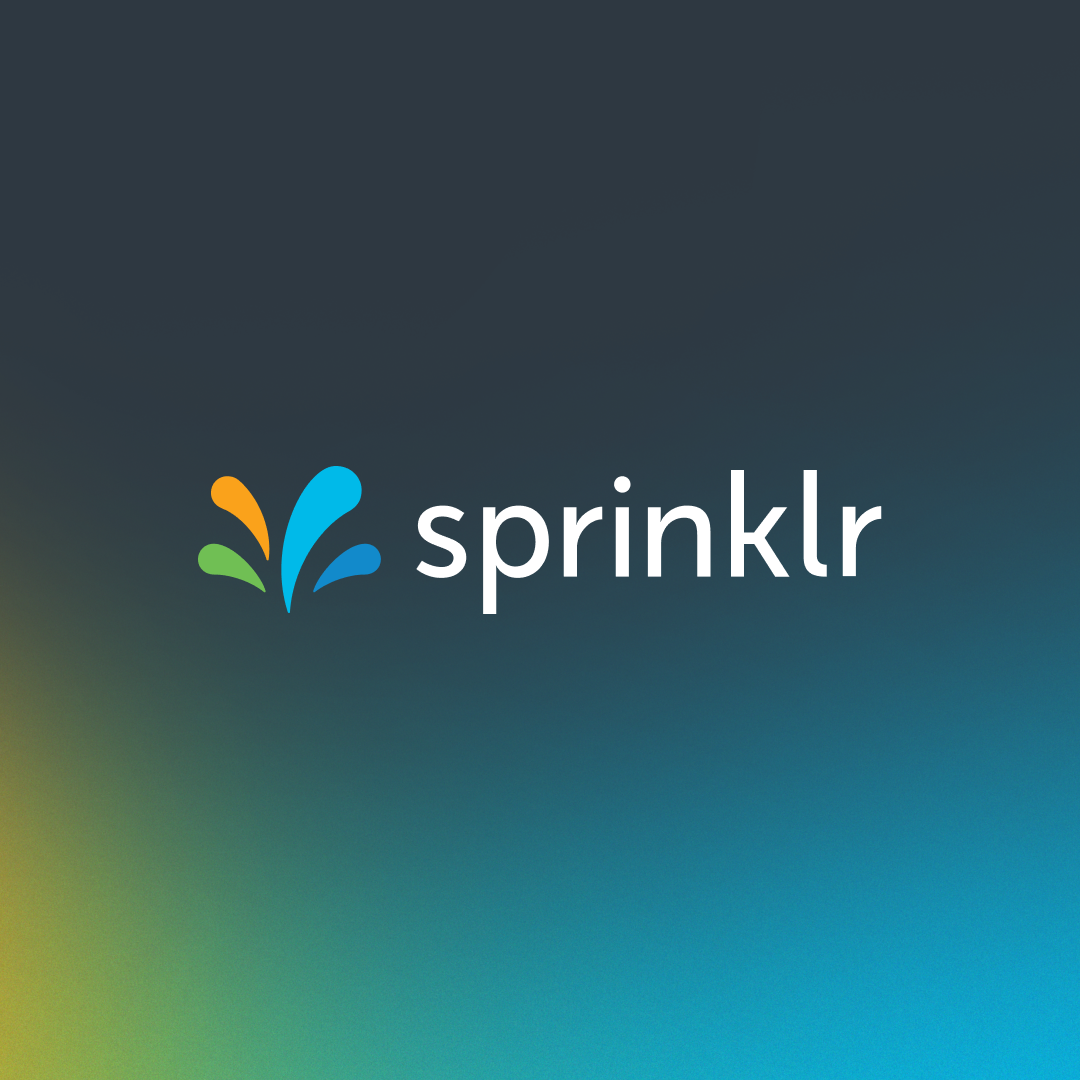Elevate CX with unified, enterprise-grade listening
Sprinklr Insights gives you real-time consumer, competitor and market intelligence from 30+ channels without the noise. Make smarter decisions, strengthen your brand, and stay relentlessly customer-led.

6 Ways To Use AI-Enabled Customer Intelligence
For years, businesses have relied on traditional methods like surveys, interviews, demographics, purchase history analyses, and similar data to glean customer insights.
While valuable, these approaches traditionally operate in silos and slow you down, costing you time and effort which you could have spent doing strategy.
Data suggests companies spend 30% of their time locating and verifying data. As if that’s not enough, 73% of such data may remain unused where it’s required, thanks to the sheer volume, number of data channels, and the overhead of detecting anomalies that bogs the process down.
But AI in customer intelligence (CI) is flipping the script, transforming scattered data into sharp, real-time insight.
It ingests and analyzes volumes of data with the least human input and help you make sense of it, suggest the next best actions to take, and predict future outcomes — thanks to unified CI platforms.
Discover six ways AI-led customer intelligence streamlines your business decisions, from data beyond demographics to helping understand sentiment and more.
What is AI-enabled customer intelligence?
AI-enabled customer intelligence refers to the use of a customer intelligence (CI) platform, or multiple CI tools, that uses machine learning (ML), natural language processing (NLP), anomaly detection, automation, and generative AI (gen AI) to process big data into business insights.
ℹ️ CI ≠ BI: Customer intelligence is gathering and analyzing data about individual and segmented consumer behaviors, preferences, and interactions to drive personalized marketing strategies. Business intelligence (BI) aggregates company-wide operational data — sales, finance, and performance metrics — to inform strategic decisions, optimize processes, and measure overall organizational health.
Essentially, an AI-led customer intelligence platform captures customer and market data from three key sources where most business data is stored:
- Owned or first- and zero-party - CRM, CDPs, point of sale (POS), web and app analytics, customer support systems, social media, surveys, emails, user-generated content, etc
- Earned or third-party - Press coverage, user-generated content, share of voice, brand mentions, public reviews, influencer mentions, media coverage, backlinks, etc
- Paid, also third-party - Search and social ads, display ads, influencer marketing, affiliate marketing, sponsored content/native marketing, programmatic ads, etc
The CI platform centralizes and processes the data through identity resolution, enrichment, segmentation, and predictive modeling, all of which are supplemented by AI.
Finally, the processed data becomes ready for activation.
The AI-led CI platform offers recommendations to act upon the data, automate workflows, and so much as support autonomous agentic responses, based on the solution.
✋ Stop hunting for scattered data. Let AI unify it and deliver answers in real-time
Imagine having customer intelligence from owned sources and 30+ social and digital channels, 400K+ media sources, 1B+ websites, and review sites on one platform. Then have AI help you discover trends, themes, and root causes so you can make informed decisions.
That’s possible with Sprinklr Insights.

✅ Speed, scale: Process historic and real-time inputs at enterprise scale, without added headcount
✅ Action, clarity: Turn raw data into prioritized next steps, not just dashboards
✅ Prediction, precision: Anticipate customer behavior and pivot your strategy before your competitors catch on
6 Enterprise use cases of AI-enabled customer intelligence
Please note that these six examples state what’s possible and hint at how it might look.
The how-to details for each one will vary depending on your existing technical and organizational setup.
There’s no one-size-fits-all enterprise-grade solution when it comes to customer intelligence!
1. Get advanced audience insights beyond demographics
What it is: Most CI platforms support feedback and segmentation capabilities from zero-, and first-party customer data, which is helpful to categorize prospective and existing customers into buckets.
These are structured data that you own, or your customers have willingly given you. But this data alone may not tell the complete picture.
The Dow Chemical Company, for market research, wanted to understand how people in three Asian markets responded to hair softness claims.
The team initially chose public product reviews to get the data but reached a dead end with a little over 1,000 mentions from just one market.
AI-led customer intelligence goes beyond the limitations of such data sources and captures unstructured data from dozens of third-party sources depending upon the CI platform’s reach.
In Dow’s case, they were able to collect 126,000+ mentions on the same topic, including auto-translated mentions through Sprinklr’s consumer intelligence platform.
Audience insights outside owned channels help validate your customer data with a much more diverse and exhaustive data lake. This helps find insights beyond demography.
According to McKinsey, organizations that integrate external data can gain a competitive edge by enhancing growth, productivity, and risk management.
How it works: CI platforms ingest billions of signals from digital, social, and traditional brand-owned sources.
They then apply clustering and NLP to identify patterns, while continually refining segments as new data arrives.
Based on the derived data, the platform creates accurate customer personas and highlights their pain points, brand affinities, and preferred engagement channels.
For example, you can identify your audience from millions of X users by analyzing publicly available data such as profile bios, followers, and text.
This data reveals their habits, lifestyles, interests, likes, dislikes, etc., along with age and gender.
Here’s an example of a demography dashboard on Sprinklr’s Audience Studies tool captured from X profiles 👇
You can view other dashboards focused on different metrics like brand affinities and create custom audience segments based on this data using Segment Manager👇
Beyond third-party data, you can always use FPDI or first-party data ingestion through XLS, XLSX, or CSV formats.
The FPDI method helps analyze sentiment, themes, and anomalies in your structured customer data like surveys and call transcripts.
CI platforms like Sprinklr integrate with Amazon S3, customer data platforms (CDPs), and CRMs (Salesforce, Microsoft Dynamics 365, etc.) to ingest first- and third-party data in real-time and give your AI-driven analysis.
🎬 See in action
A global optical solution brand uses customer intelligence as a Social Concierge to support customers throughout their lifecycle, not just on service calls. Since implementation, it has reduced first-response SLAs by six hours and is closing cases four times faster!

2. Analyze the voice of the customer and sentiment in real-time
What it is: As marketers, we’re obsessed with quantitative or structured customer data. It is also the holy grail of intelligence and for good reasons.
But a huge chunk, 80-90% of customer data is unstructured or difficult to measure.
Beyond your typical NPS and CSAT scores, CTRs, and case resolution rates, there is customer data awaiting interpretation on social media threads, blogs, forums, review sites, and so on.
AI-led customer intelligence platforms use NLP and LLMs to analyze billions of customer conversations (aka the voice of the customer) from dozens of channels outside your structured engagement channels and predict the sentiment and topical affinities.
👉 You may want to know: What is sentiment analysis
This is something general customer metrics cannot tell and helps you go beyond the whats into the whys to inform marketing, sales, content, and CX strategies.
How it works: CI platforms ingest data from social media, surveys, support tickets, images, and billions of conversational data, process it using NLP models, classify sentiment (positive, negative, neutral), and flag key themes.
Some CI solutions offer advanced AI to recognize industry-specific customer data and sentiment while filtering out the rest so that you can trace and predict only what is relevant to your brand.
For example, you can uncover the VoC and sentiment data in real time using a query-based Quick Search on Sprinklr Insights.
A simple Boolean search can fetch conversations that have specific keywords you want to track. Simply add your keywords to the Quick Search box and hit Search to run the query.
Sprinklr will analyze billions of conversations and return a dashboard with pre-populated widgets on different metrics about the topic, such as total mentions, reach, sentiment, etc.
You can run similar queries for more specific output or build entirely custom dashboards to get the voice of the customers on hyper-specific topics such as product ideas, and customer experiences, and benchmark them against competitors.
3. Predict customer behavior
What it is: Predictive AI models help forecast customer actions — such as churn, upsell propensity, customer satisfaction, or purchase timing — by learning from historical or real-time customer data.
CI platforms with this capability typically sit at the intersection of multiple technologies your team uses to serve customers.
It can, for example, utilize the data on your CRM, CDP, or customer service platforms to analyze their activities and predict outcomes.
How it works: Algorithms such as boosting trees and GRUs ingest recency, frequency, monetary (RFM) metrics, transaction history, and engagement signals to predict future behavior, continuously retraining AI on new outcomes.
For example, AI-led customer intelligence platforms can integrate with your service software and use machine and deep learning to analyze historical engagement, sentiment, and predict CSAT trends.
For example, Sprinklr’s Customer Care Topic Analysis dashboard is an example of CI that analyzes the myriad reasons customers reach out for support across various channels.
On the dashboard, you can use Smart Insights (Sprinklr’s native AI) to probe into specific data points that matter to you 👇
Sentiment data, conversational themes, etc., help derive churn‑likelihood scores if not definitive churn signals.
For example, a surge in negative sentiment around a new feature release could be a churn signal.
You can use this data to proactively address at‑risk customers through outbound efforts such as offering priority support or dedicated success managers to qualified customers.
In another example, a low CSAT/NPS score from recent support conversations could indicate the likelihood of churn.
AI can also help spot the top reasons why customers contact your brand and highlight the biggest opportunities for eliminating unnecessary contact.
👉 You may like: Predictive analytics: The next big thing in customer service
4. Manage crisis and brand protection
What it is: Customers often leave micro-indicators of frustrations and dissatisfaction with your brand before they escalate or churn.
The same is true for opportunities; you can identify signals in conversations that could translate into improved content, updated products, and better CX.
A CI platform traces such indicators in owned and earned channels where customers interact with or about your brand, such as in social media comments, forum discussions, and customer service conversations on calls, emails, and tickets.
Philadelphia-based marketing and advertising firm Athena relies on CI to support its clients, most of which sponsor high-profile events, with real-time crisis alerts and strategic insights.
Instead of hours, Athena flags brewing issues or juicy PR opportunities to clients during live events in less than 10 minutes. This abilty to do real-time data monitoring for proactive and predictive analysis is now Athena’s service hallmark! Learn more about Athena's story here.
How it works: NLP models perform Named Entity Recognition (NER) to identify brand references and classify sentiment — detecting dissatisfaction, sarcasm, or urgency in posts.
Computer vision algorithms (e.g., YOLO, CNN‑based classifiers) scan images and videos for logos, products, or visual anomalies that may signal emerging issues.
A good demonstration of AI in crisis management is Sprinklr Insights’ Global Crisis Feed.
The platform uses AI to present potentially critical messages from across social channels, which are yet to become full-blown👇
AI buckets conversations in auto-identified categories. The moment a crisis bursts out, Sprinklr AI creates a crisis card painting a picture of the crisis and the top factors behind it.
You can take prompt actions on top of these cards, like sharing them with users, creating support cases and workflows, automated publishing, and campaign monitoring.
🎬 See AI-led media monitoring and crisis alerts in action
An unfolding crisis and mitigation efforts cannot flow together. You’ve got to stay on top of events before they become a full-blown crisis. Learn how you can use AI for crisis management.

5. Detect anomaly and their root causes
What it is: When dealing with big data, any inconsistency can set you back. AI-based anomaly detection in customer intelligence platforms can flag unusual patterns in metrics — like a sudden drop in web conversions — for a swift investigation.
How it works: AI uses time-series models (e.g., GRU) to establish normal behavior baselines, deviations trigger alerts, and generative AI surface likely root causes by correlating anomalies with upstream events.
For example, Smart Alert on Sprinklr Insights uses AI to analyze historical data to capture trends in the metrics of your choice, like volume, engagement, sentiment, etc.
Once an anomaly is detected, Sprinklr uses root cause analysis to drill into the data dimensions — time of day, channel, campaign ID, and message type — and suggest the most likely drivers.
You can also deliver insights to other stakeholders via email, SMS, mobile push, or in‑platform dashboards as soon as an anomaly is confirmed.
6. Visual listening or content recognition
What it is: Analyzing text-based data has been the gold standard for CI, and it continues to remain critical.
But customers today communicate using visuals as much as they do through text. Memes, images, reels, videos, etc. There’s data to suggest that 91% of consumers prefer visual content to written.
AI can capture visual cues about your brand or related factors in visuals shared by the public, which you can analyze for incredible customer intelligence that only text will not give.
You will see how your customers perceive your brand and talk about it through visuals such as images, memes, and videos, and use the information to craft your PR, content, and marketing strategies.
How it works: Deep learning models (e.g., YOLOv8) detect and classify visual objects and LLMs analyze surrounding captions to infer the sentiment and context of visual content.
For example, you can analyze images, memes, and videos for your brand logo, assets, or contextual presence in public conversations using Visual Listening.
Such insights typically get bypassed in traditional listening. However, AI-led customer intelligence platforms like Sprinklr Insights can capture that from hundreds of millions of public conversations outside owned channels 👇
Are there too many memes on something negative about your brand? It may be a cue to counter with a positive meme to balance out the impact.
Similarly, is there a viral micro-trend featuring your brand in user-generated images? This could indicate an opportunity to rely on the trend using influencers to multiply the impact.
Enablers of AI-driven customer intelligence
Here are the technologies that form the backbone of an AI-led customer intelligence solution:
Unified solutions
Integrating data from diverse sources such as CRM, CDPs, social media, customer feedback, and transactional records into a centralized platform is foundational.
Consolidating disparate data sources allows AI models to analyze comprehensive customer profiles, leading to more accurate and personalized insights.
LLMs
Large language models, or AI trained on massive text data, excel at comprehending human language.
In a CI setup, LLMs contextualize content into sentiment, tones, themes, talking points, and other linguistic, cognitive, and topical analyses to help you go beyond surface-level metrics and data.
NLP
Natural language processing powers sentiment analysis, intent detection, emotion classification, topic modeling, and entity extraction across dozens of languages.
Analyzing the sentiment helps gauge emotional tone across touchpoints and identify the purpose, goal, tone, themes, and intent behind a customer’s message, among other structured insights.
Gen-AI
Generative AI learns from customer data and creates contextual content such as texts, images, graphs, tables, etc. As a result, you can take swift actions right from the CI platform and deliver output at scale.
Vertically tailored AI
This AI, trained on industry-specific data, produces accurate insights and contextual suggestions from the customer intelligence platform to help you make sense of vast amounts of metrics.
Ethical AI practices and governance
Implementing AI in customer intelligence responsibly involves establishing ethical guidelines and governance frameworks to ensure fairness, transparency, and accountability.
You must address biases in AI models, chart customer data privacy policies, and enforce rigorous governance capabilities in the CI platform for compliance and customer trust.
Skilled talent and org alignment
You need skilled professionals, including data scientists, AI specialists, and domain experts to deploy AI-led customer intelligence solutions.
Your organization and culture must align to support data-driven decision-making from AI-derived insights.
Turn big data into big clarity with Sprinklr’s consumer intelligence platform
The real outcome of customer intelligence, done right, is being able to analyze and draw actionable insights from the data rather than just gather it in one centralized location.
Customer data is proliferating as are the channels through which they engage. And CI solutions are increasingly playing catch-up with AI and unified platforms to keep up with the processing demands of big data in 2025.
AI-led customer intelligence solutions like Sprinklr Insights help you gather and analyze your customer’s data — and act from the same unified platform.
Curious to see how you can use AI-led customer intelligence to make informed business decisions?
Frequently Asked Questions
AI transforms B2B customer intelligence by unifying your customer data across touchpoints, for predictive insights, and personalizing engagement at scale. For example, Sprinklr’s AI-powered platform consolidates interactions from over 30 channels, providing a 360° customer view. Such tools can identify patterns in sentiment, buying signals, and account health, allowing you to proactively address client needs and optimize account strategies.
Key challenges include data silos, lack of real-time insights, and difficulty scaling AI solutions. Modern CI platforms like Sprinklr Insights address these by offering a unified platform that integrates disparate data sources, delivering real-time analytics and scalable AI models.
Absolutely. You can access vertically tailored AI models tailored to industry-specific needs. It can capture relevant metrics and customer behaviors and give highly accurate insights. For example, Sprinklr Insights has out-of-the-box customizable AI solutions that adapt to various sectors, from retail to finance. The insights these AI models generate are pertinent and actionable for each unique industry context.
Yes. CRM analytics typically focus on structured data within customer databases, analyzing past interactions. In contrast, AI-driven customer intelligence encompasses both structured and unstructured data from multiple sources, providing real-time, predictive insights. For example, Sprinklr Insights captures both first-party and third-party customer data in one platform for holistic customer intelligence.
Emerging trends include the rise of agentic AI, which enables autonomous decision-making, and the integration of AI across customer-facing operations for personalized outputs. AI-led customer intelligence platforms like Sprinklr are developing AI solutions that not only analyze customer data but also proactively engage and respond to customer needs, setting new standards in customer experience management.









